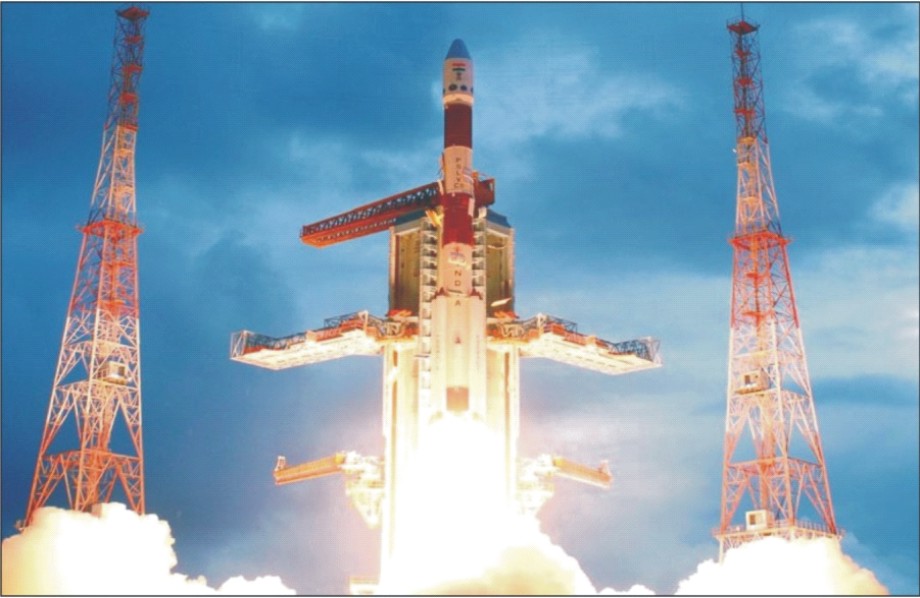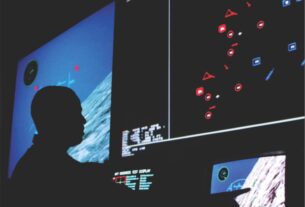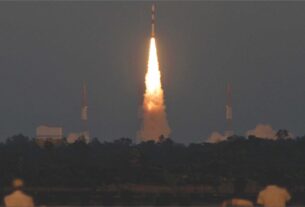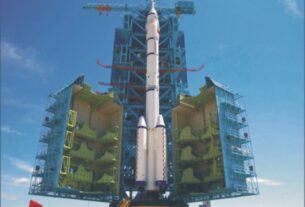Boosting cooperation
In the context of growing frequency of Indian space missions including ambitious plans for deep space planetary probes and manned flight, Indian Space Research Organisation (ISRO) is seriously exploring the possibility of roping in the Indian industry in a big way for the production and delivery of communications satellites and India’s only operational space vehicle, the four stage space workhorse PSLV (Polar Satellite Launch Vehicle) in a ready to use condition.
Evidently, the prevailing industrial culture in India lacks in robustness and skill base to deliver the entire space systems on a turnkey basis.
The industrial infrastructure in North America and West Europe is mature and evolved enough to deliver the entire space vehicles and satellites in an integrated manner as per the requirements of the users.
Perhaps, ISRO too is keen on driving its space missions on the back of the industrial support in the years ahead.
Currently, around 500 Indian industrial units, both in the private and public sectors, are contributing to various projects of ISRO by way of the supply of hardware, services and expertise.
The idea behind roping in the Indian industries for the production and delivery of satellite and launch vehicle systems on a turnkey basis is to enable ISRO scientists and engineers focus more on research and development aimed at evolving the concept of next generation satellites.
This approach would free ISRO from engaging itself in the repetitive exercise of building communications satellites and launch vehicles.
According to K Radhakrishnan, Chairman, ISRO, “We want to explore the possibility of producing PSLV and the communications satellites through the industry.”
Challenging task
However, ISRO would need to interact with the industry from a variety of angles to zero in on the models and evolve a well conceived plan to involve the Indian industry in the task of producing and delivering of communications satellites and launch vehicles in a timely fashion.
Here, ISRO would be required to do a lot of hand holding for sometime to come so as to prepare the Indian industry for taking up the challenging task of building the entire, integrated satellite and space vehicle systems and their delivery on time in ready to use condition.
A consortium approach would be ideal for meeting this objective in economically viable and timely fashion.
Providing a pointer to the advanced technology systems that ISRO would be developing, Radhakrishnan revealed that over the next five years, ISRO would develop a 10,000 watts communications satellite which can accommodate up to 60-70 transponders. This satellite would also feature the next generation high frequency Ka-band transponders.
In the quest of realizing the objective of self reliance in the national space programme, ISRO has been pursuing a conscious policy of building up and nurturing the industrial capabilities in the country to maximally support the Indian space activities.
Looking into the future, ISRO is of view that the role that the Indian industry will play would be pivotal in realizing advanced planetary missions, operational heavier class of communications satellites, cartographic as well as geo imaging satellites for earth observation and in the setting up a constellation of regional navigation satellites.
Antrix Corp, the commercial arm of the Indian space programme, with the active support of the Indian industry, is gearing up to meet the challenges of competing in the multi-billion dollar global space market in a big way.
Since its inception two decades back, Antrix has been quietly marketing the Indian space capabilities including launch service to the customers from across the globe.
The global distribution of resources data obtained from India’s IRS constellation of earth observation satellites through an expanding network of international ground stations is a growing source of revenue for Antrix.
In the immediate future, Antirx has plans to strengthen the infrastructure for international data sales and business development in value added services.
Incidentally, the IRS constellation described as one of the largest constellations of remote sensing satellites in operation in the world today, provide data in a variety of spatial, spectral and temporal resolutions, which are effectively used for resources management purposes.
The biggest trump card of Antrix is its success in marketing the services of the PSLV for launching the satellites of the international customers.
PSLV has been projected as a cost efficient launch vehicle for delivering payloads into near earth and middle earth orbits with a high degree of reliability.
The most prestigious and the highest ever revenue earning contract for the PSLV service which Antrix has won pertains to the order it has bagged from Astrium SAS (an EADS company) for the launch of 800-kg Spot-6 French advanced remote sensing satellite.
The PSLV flight that will launch Spot-6 in the third quarter of this year will also deliver into orbit a 15-kg.Japaanese space probe as a piggyback payload.
For this mission, a core alone version of PSLV without its usual six strap on boosters will be pressed into service.
So far, using PSLV described as a versatile and reliable space vehicle, Antrix has launched 27 satellites belonging to customers from countries such as Algeria, Italy, Israel, Luxembourg, Belgium, Germany, Switzerland, Indonesia, Canada, Singapore and South Korea.
Antrix sees revenue surging 20 per cent annually over the next five years on the back of the expanding launch service centring round PSLV and the introduction of yet to be qualified three stages GSLV-MKII and GSLV-MKIII.
PSLV mission
The strong point of PSLV is said to be its proven multi-mission, multi payload capability in a single launch. In a spectacular display of its awesome prowess, the PSLV mission of April 2008 delivered as many as ten satellites into orbit in one go.
Indeed, the flawless PSLV mission has boosted the commercial prospects of the launch service offered by Antrix.
Sources in Antrix said that the multiple launch capability and the high degree of precision with which satellite payloads are launched into orbit have made PSLV an attractive and economically viable proposition for launching small satellite payloads.
The versatility of PSLV is highlighted by the fact that it can launch satellites into polar/sun-synchronous, geosynchronous transfer orbit, highly elliptical and low earth orbits.
PSLV was originally designed and developed to serve as a workhorse for launching Indian built IRS series of earth observation satellites weighing one tonne but subsequently it was promoted as an affordable launch platform for orbiting small satellites of international customers.
In a development of significance, in September 2008, Astrium, a fully owned subsidiary of the European aerospace and defence consortium EADS, entered into an agreement with Antrix Corporation on the utilization of PSLV services.
This agreement enables Astrium to offer attractive solutions in the international market for in orbit delivery of earth observation satellites.
All said and done, with PSLV alone India cannot hope to make it big in the global market for launching satellites.
For India to make ground breaking progress in the satellite launch market, ISRO would need to deploy the three stages GSLV-MKII and GSLV-MKIII, both of which are yet to be qualified for routine operations.
In the area of satellite technology, through the alliance with EADS Astirum, Antix has delivered to the customer high performance W2M and Hylas satellites.
As part of its plan to emerge as a major player in the global market for the delivery of custom made satellites on a turn-key basis, Antrix has submitted several proposals to the satellite operators offering satellites based on flight proven satellite platforms.
To prepare the ground for manned flight slated for a take off in 2016, ISRO has taken up the challenge of developing space suit, the technology of which is the closely guarded secret of a handful of space faring nations.
To stay at the forefront of this frontier research area, ISRO has entered into an agreement with the Bangalore based Defence Bioengineering and Electro-medical laboratory of (DEBEL), a constituent of the state owned Defence Research and Development Organisation (DRDO) for the design and development of space suit for the use of the two or three Indian astronauts who will make it into space as part of the human space flight mission.
As the lead agency for the development of space suit, DEBEL will leverage the expertise it has already built up in areas such as life support systems, technical textiles and materials.
Of course, DEBEL will make use of the Indian industrial expertise to the maximum extent in its quest of developing the space suit.
For building the crew vehicle for the manned flight, ISRO will make use of the Russian assistance under the Indo-Russian space cooperation program.
Of course, Indian industry will fully well join hands with ISRO in the task of building various advanced technology systems for the manned flight.
Technology transfer
Transfer of technologies developed in various centres of ISRO to the Indian industries for commercialisation is a major ISRO initiative aimed at boosting the industrial capability in the country to take up the challenging assignment of the Indian space programme.
On another front, ISRO is confident that industry will make use of the technologies developed for the national space programme for meeting a variety of commercial and societal needs.
For instance, the technology of Mobile Satellite Type C Reporter terminal developed by ISRO has commercial and societal applications in fleet monitoring, remote data acquisition and SOS messaging during distress.
With a little fine tuning, this product can be tailor made to meet the applications related to GPS tracking for Indian roads, marines and railway segments.
Indian space program has established a symbiotic relationship with the Indian industry and over the year Indian industry has matched the pace of ISRO in accomplishing a variety of experimental, operational and advanced missions of national importance.
ISRO has been able to strengthen the process of productionization through industries by adopting vendor development, vendor qualifications and quality control approaches.
The pace of participation of Indian industry in the country’s space programme is expected to expand significantly in view of the growth in space transportation and satellite systems.
In the long run, the aim is to have industry as a risk sharing partner and this will be achieved by involving the industry from the preliminary stage of development of space systems.
Strategies adopted on standardisation of subsystems and reaching out to the industries with bulk ordering approach has paid rich dividends. The magnitude of industry contribution in the area of launch vehicles has grown apace to meet the needs of already operational PSLV, and under qualification GSLV-MKII and GSLV-MKIII.
Thanks to the hand holding by ISRO, Andhra Sugars based in Tanuku in Andhra Pradesh is now producing a range of liquid propellants including liquid hydrogen for the launch vehicles developed by ISRO.
ISRO has made investments to develop strategic partnership with the private sector industry in a big way.
Active cooperation in the form of procurement control, know-how transfer and provision of technical consultancy has enabled ISRO to meet the increasing challenges of advanced technology and handling complex manufacturing jobs.
ISRO has embarked on a host of productionisation initiatives at external work centres to meet the ever increasing requirements of the Indian space program, keeping in view the quality, redundancy, reliability and shorter lead times that are required for the space systems.
As part of the drive towards space industrialisation, the approach of Integrated Production of Components and Modules (IPCM) in association with the industry has been adopted in the private sector.
The work under IPCM covers the delivery of the fully assembled and tested components and modules of the stages of PSLV and GSLV-MKII and thruster valves for GEOSATS.
The major achievements have been the delivery of pneumatic connectors and safety couplers for flight segments. ISRO continues to source many of the important requirements including propellant tanks, cryo structures, engines and satellite thruster parts from external work centres-both in private and public sector.
In the launch vehicle avionics area, the services of multiple vendors for screening, testing and evaluation of packages have been utilized.
Long term contracts with industries have been established for regular supply of Stage Auxiliary System (SAS) components.
The setting up of a Titanium Sponge Production Plant by through the involvement of industry-with ISRO’s support-is considered a landmark development in the growing Industry-ISRO cooperation.
ISRO is of view that considering the potential that exists for application of space technology in India and other markets, the role of Indian industries in the space programme of the country is poised for a quantum growth.





